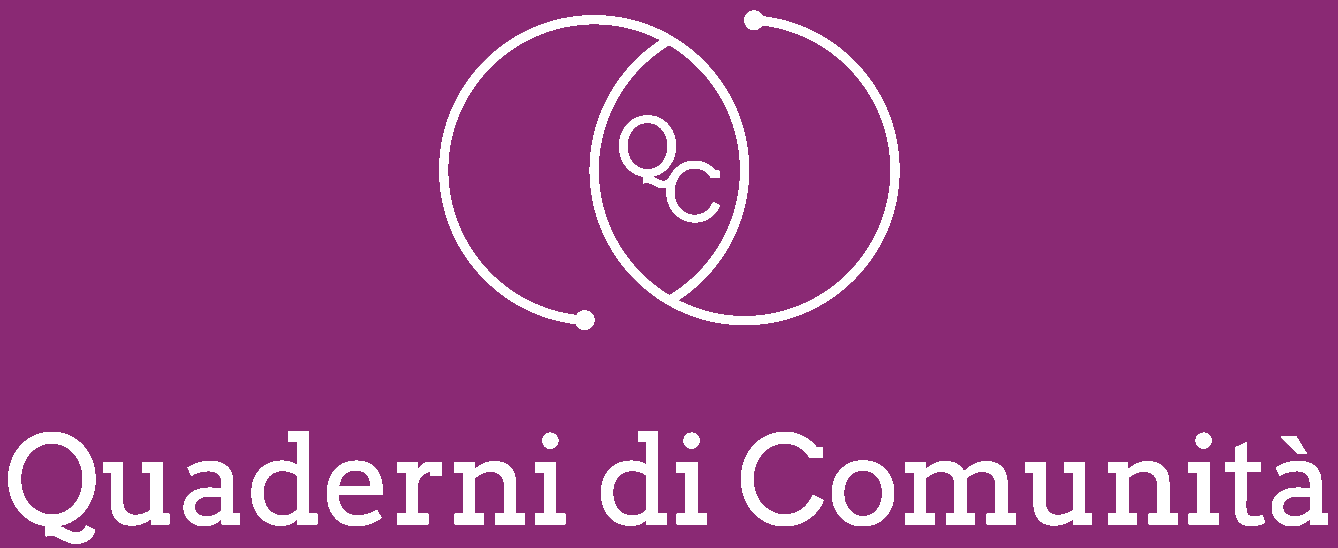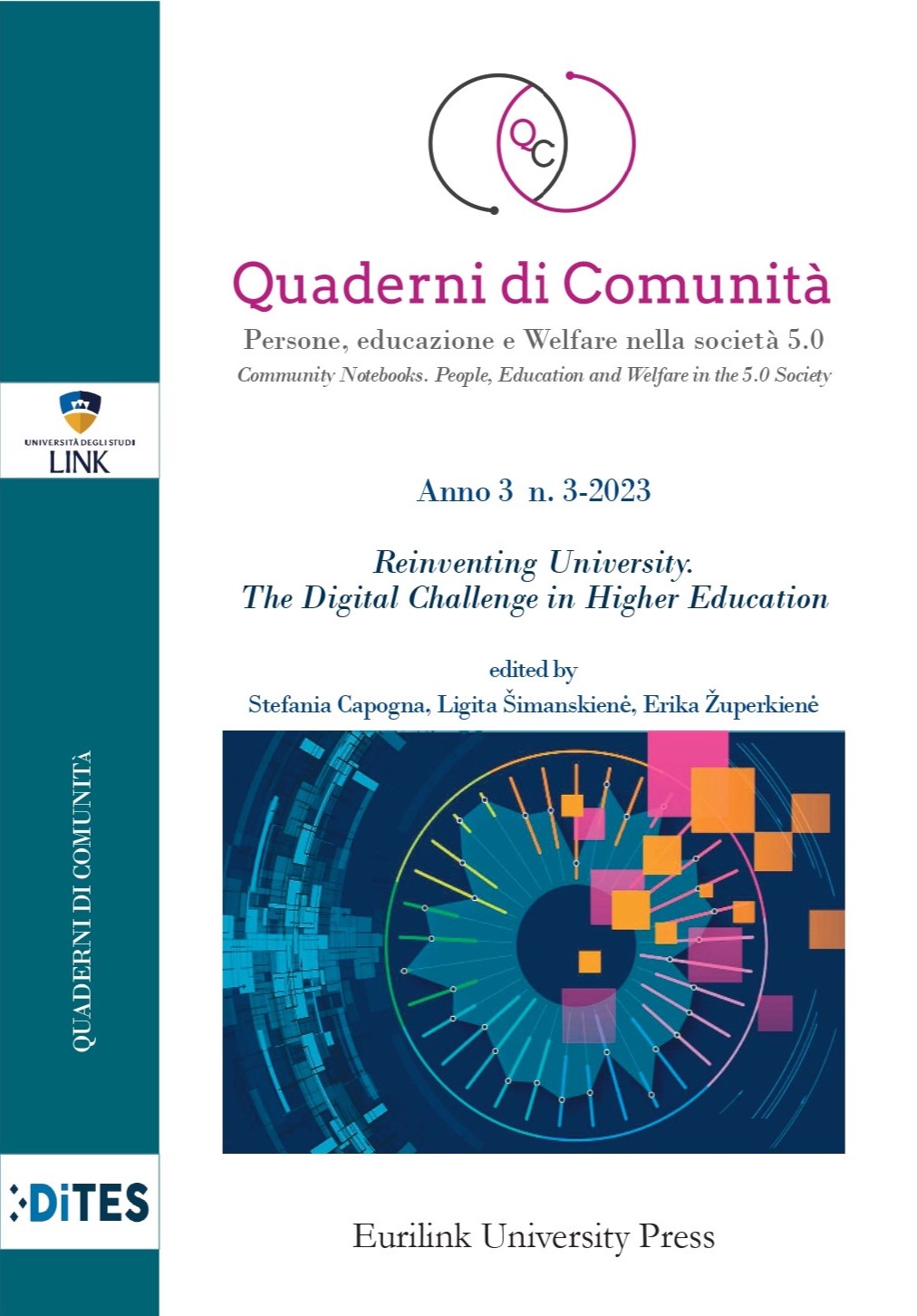The impact of the pandemic on young people's risk behaviour: risky challenges
DOI:
https://doi.org/10.61007/QdC.2023.3.162Keywords:
social challenge, risk-taking, self-improvement, edgework, sensation seeking, narcissism, self-harmAbstract
The contribution analyzes the risky social challenges highlighted by the international press, implemented during the pandemic period with a pedagogical-communicative approach linked to the sociology of risk. The viral phenomenon of challenges is observed in human behaviours with narcissistic and self-harming traits typical of adolescence. It is related to the hybridization of the overlapping of the communication and social interaction space with its digital virtualization.
References
Al-Menayes, J.J. (2015), Dimensions of social media addiction among university students in Kuwait, Psychology and Behavioral Sciences, 4(1), 23- 28.
Aldi, G. (2021), Menti iconiche e patologia adolescenziale, Rivista Telos, (N.1/2021).
Alfonso S., Scirica S., Di Pierro R., Gallucci M. (2020), Narcigram: The expression of pathological narcissistic traits on Instagram, in Psicologia Contemporanea n. 283, 2021 - https://www.psicologiacontemporanea.it/blog/tra-narcisismo-culturale-e-social-la-sindrome-dellinfluencer/.
Andreassen CS, Pallesen S, Griffiths MD., The relationship between addictive use of social media, narcissism, and self-esteem: Findings from a large national survey. Addict Behav 2017; 64: 287-93. [http://dx.doi.org/10.1016/j.addbeh.2016.03.006] [PMID: 27072491].
Andreassen, C. S., Billieux, J., Griffiths, M. D., Kuss, D. J., Demetrovics, Z., Mazzoni, E., & Pallesen, S. (2016), The relationship between addictive use of social media and video games and symptoms of psychiatric disorders: A large-scale cross-sectional study, Psychology of Addictive Behaviors, 30(2), 252-262.
Baker, L.R. e Oswald D.L. (2010), Shyness and online social networking services, «Journal of Social and Personal Relationships», vol. 27, n. 7, pp. 873-889.
Barry, C. T., Doucette, H., Loflin, D. C., Rivera-hudson, N., & Herrington, L. L. (2017). Let me take a Theoretical model: associations between self- photography, narcissism, and self- esteem. Psychology of Popular Media Culture, 6(1), 48–60.
Bell, D., (1973) The coming of post-industrial society: a venture in social forecasting, New York, 1973.
Boyd, D., Jenny, R., Leavitt, A. (2011). Pro-self-harm and the visibility of youth-generated problematic content. I/S: A Journal of Law and Policy for the Information Society, 7(1):1-31.
Boyer, T.W. (2006), The development of risk-taking: A multi- perspective review. Developmental Review, 26, 291–345.
Bourdieu, P. (1984). Distinction: A social critique of the judgement of taste (R. Nice, Trans.). London: Routledge & Kegan Paul.
Bruner, J., (1991), The Narrative Construction of Reality, Critical Inquiry, vol. 18, no. 1, 1991, 1–21. JSTOR, http://www.jstor.org/stable/1343711. Accessed 19 Feb. 2023.
Buffardi, L. E., & Campbell, W. K. (2008), Narcissism and social networking web sites, Personality and Social Psychology Bulletin, 34, 1303–1314. https:// doi.org/10.1177/0146167208320061.
Bunn, M. (2017), Defining the edge: choice, mastery and necessity in edgework practice, Sport in Society, DOI: 10.1080/17430 437.2017.1284800.
Burke, M., Marlow C. e Lento T. (2010), Social network activity and social well-being, «Postgraduate Medical Journal», n. 85, pp. 455- 459.
Campbell, W. K. & Foster, J. D. (2007), The Narcissistic Self: Background, an Extended Agency Model, and Ongoing Controversies. In C. Sedikides & S. Spencer (Eds.), Frontiers in social psychology: The self. Philadelphia, PA: Psychology Press, 115-138.
Campbell, K.W., e McCain, J., (2018). Theoretical perspectives on narcissism and social media: The Big (and Beautiful) Picture. In Handbook of Trait Narcissism: Key Advances, Research Methods, and Controversies, a cura di Anthony D. Hermann, Amy B. Brunell, e Joshua D. Foster, 443–53. Cham: Springer International Publishing, 2018. https://doi.org/10.1007/978-3-319-92171-6_48.
Chen, B. e Marcus, J. (2012), Students’ self-presentation on Facebook: An examination of personality and self-construal factors, «Computers in Human Behavior», n. 28/2012, 2091-2099.
Claes, L., Vandereycken, W. (2007). Self-Injurious behavior: differential diagnosis and functional differentiation. Comprehensive Psychiatry, 48/2007, 137-144.
Ferraro, F. (2008), Linee d’ombra e di confine: vertici psicoanalitici per una riflessione. Relazione al Convegno della Società Psicoanalitica Italiana “Violenza e Simbolizzazione”, Napoli, 2008.
Gebauer, J.E., Sedikides, C., Verplanken, B., Maio, G. R. (2012), Communal narcissism, in Journal of Personality and Social Psychology.
Giacomin, M., e Jordan, C. H. (2015), Validating power makes communal narcissists less communal, Self and Identity, 14(5), 583- 601.
Gonzales, A.L. e Hancock J.T. (2011), Mirror, mirror on my Facebook wall: Effects of exposure to Facebook on Self-Esteem, «Cyberpsychology, Behavior, and Social Networking», n. 14, pp. 79- 83.
Gosling S.D., Augustine A.A., Vazire S., Holtzman N. e Gaddis S. (2011). Manifestations of personality in online Social Networks: Self- reported Facebook-related behaviors and observable profile information, «Cyberpsychology, Behavior, and Social Networking», vol. 14, n. 9, pp. 483-488.
Jeammet, P. (1995), Adolescence et suicide. Paris: Masson.
Kardefelt-Winther, D., Heeren, A., Schimmenti, A., VanRooij, A., Maurage, P., Carras, M., Edman, J., Blaszczynski, A., Khazaal, Y., & Billieux, J. (2017), How can we conceptualize behavioural addiction without pathologizing common behaviours? Addiction, 112(10), 1709–1715.
Kuss, D. J., e Griffiths, M.D., (2017), Social networking sites and addiction: Ten lessons learned. International Journal of Environmental Research and Public Health, 14(3), 311.
Lasch, C., (1978), The culture of narcissism, Norton, New York.
Liotti, G., Lorenzini, R., Note sul narcisismo nella prospettiva cognitivo-evoluzionista, in “Quaderni di psicoterapia cognitiva” 42/2018, pp 113-139, DOI: 10.3280/QPC2018-042008.
Livingstone, S. (2008), Taking risky opportunities in youthful content creation: teenagers’ use of social networking sites for intimacy, privacy and self- expression. New Media & Society, 10(3), 393- 411.
Lupton, D., (2014), Digital Sociology. London: Routledge.
Lupton, D., Tulloch J., (2002). Health, Risk & Society, Vol. 4, n° 2/2002.
Lyng, S. (1990), Edgework: A Social Psychological Analysis of Voluntary Risk Taking. American Journal of Sociology, 95 (4): 851 - 86.
Malagoli Togliatti, M. (2004), Costruzione delle relazioni familiari all’interno della famiglia, Convegno Internazionale Sviluppo della persona e promozione del senso, Studi Filosofici di Napoli, 22 Ottobre.
McCain, J. L., & Campbell, W. K. (2016), Narcissism and Social Media Use: A Meta-Analytic Review, Psychology of Popular Media Culture. Advance online publication. http://dx.doi.org/10.1037/ppm0000137.
Milani, M., (2014), Adolescenti in Facebook tra narcisismo ed empatia. Media Education, 5(1), 36-56.
Miller, J. D., Hoffman, B. J., Gaughan, E.T., Gentile, B., Maples, J., & Keith Campbell, W. (2011). Grandiose and vulnerable narcissism: A nomological network analysis. Journal of Personality, 79(5), 1013–1042. https://doi.org/10.1111/j.1467-6494.2010.00711.x.
Mitchell, SA (1993), Hope and dread in psychoanalysis. Basic Books, New York, p. 106.
Munno, D., Cappellin, F., Saroldi, M., Bechon, E., Guglielmucci, F., Passera, R., & Zullo, G. (2017), Internet addiction disorder:
Personality characteristics and risk of pathological overuse in adolescents, Psychiatry Research, 248, 1-5.
Pantic, I, Milanovic A, Loboda B, et al. Association between physiological oscillations in self-esteem, narcissism and internet addiction: A cross-sectional study, Psychiatry Res 2017; 258: 239-43.
Paris, J. (2013). La psicoterapia nell’età del narcisismo, (Tr. it. Raffaello Cortina Editore), Milano 2013, 103.
Peluchette, J. e Karl, K., (2010), Examining Students’ Intended Image on Facebook: “What Were They Thinking?!, «Journal of Education for Business», vol. 85, n. 1, pp. 30-37.
Pittman, M., Reich, B., Socialmedia and loneliness: Why an Instagram picture may be worth more than a thousand Twitter words. Comput Human Behav 2016; 62: 155-67. [http://dx.doi.org/10.1016/j.chb.2016.03.084].
Reed, P., Osborne LA, Romano M., Truzoli R., Higher impulsivity after exposure to the internet for individuals with high but not low levels of self-reported problematic internet behaviours. Comput Human Behav 2015; 49: 512-6. [http://dx.doi.org/10.1016/j.chb.2015.03.064].
Reed, P., Bircek N., Osborne L., Viganò C., Truzoli R., Visual Social Media Use Moderates the Relationship between Initial Problematic Internet Use and Later Narcissism. The Open Psychology Journal, 2018 - DOI: 10.2174/1874350101811010163, 2018, 11, 163-170.
Rodham, K., Hawton, K., & Evans, E. (2004), Reasons for deliberate self- harm: Comparison of self-poisoners and selfcutters in a community sample of adolescents, Journal of the American Academy of Child & Adolescent Psychiatry, 43, 80-87.
Russ, E., Shedler J., Bradley R., Westen D. (2008), Refining the construct of narcissistic personality disorder: Diagnostic criteria and subtypes, America Journal of Psychiatry, 165, 1473-1481.
Seidman, G. (2013), Self-presentation and belonging on Facebook: How personality influences social media use and motivations, Personality and Individual Differences, n. 54/2013, 402-407.
Smithson, J., Sharkey, S., Hewis, E., Jones R.B., Emmens, T., Ford, T., Owense, C. (2011), Membership and Boundary Maintenance on an Online Self- Harm Forum. In Qual Health Res, 2011, 21.
Sorokowski, P., Sorokowska, A., Oleszkiewicz, A., Frackowiak, T., Huk, A., & Pisanski, K. (2015), Selfie posting behaviors are associated with narcissism among men. Personality and Individual Differences, 85, 123–127. https://doi.org/10.1016/j.paid.2015.05.004.
Stern, D.N. (1985), Il mondo interpersonale del bambino (tr. it. Torino, Bollati Boringhieri), 1987.
Tiidenberg, K., (2015), Great faith in surfaces – A visual narrative analysis of selfies, Cambidge Scholars Publishing, 233-56.
Turp, M. (2003), Hidden Self-harm: Narratives from Psychotherapy, Jessica Kingsley Publishers, UK.
Twenge, J. M., & Campbell, W. K. (2009), The narcissism epidemic: Living in the age of entitlement, New York: Simon and Schuster.
Vrouva, I., Fonagy, P., Fearon, P.R.M., Russow, T. (2010), The risk taking and self-harm inventory for adolescents: development and psychometric evaluation, Psychological Assessment, 852-65.
Weinstein, N.D. (1980), Unrealistic Optimism about future life events, Journal of Personality and Social Psychology, 39, 5, 806- 820.
Zuckerman, M. (1971), Dimension of sensation seeking, Journal of Consulting and Clinical Psychology, 36, 1, 45-52.
Downloads
Published
How to Cite
Issue
Section
License
Copyright (c) 2023 Quaderni di comunità. Persone, Educazione e Welfare nella società 5.0

This work is licensed under a Creative Commons Attribution-NonCommercial-NoDerivatives 4.0 International License.







